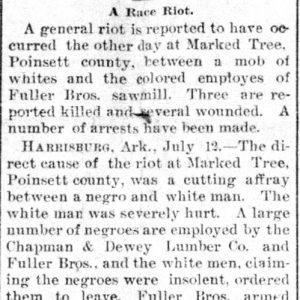calsfoundation@cals.org
Marked Tree Race Riot of 1894
In July 1894, newspapers reported on a race riot in Marked Tree (Poinsett County). The incident precedes others that occurred later during the 1890s, part of a pattern of intimidating African American laborers in Arkansas. The fact that employers hired Black workers, who were paid less, to replace white workers caused white employees to threaten African Americans, trying to drive them out. If they were unsuccessful, whites sometimes resorted to actual violence. The practice peaked in 1896 and 1897 and included incidents at Hawthorne Mills in November 1896 as well as two in December 1896, one on the Cotton Belt Railroad and another near McNeil (Columbia County). Another erupted among lumber workers near Prescott (Nevada County) in May 1897.
The trouble at Marked Tree started around July 15, 1894. Although reports of the event seem to have been scant in Arkansas, it was covered in newspapers around the country. There is disagreement among the reports as to the number of African Americans wounded and killed. A July 13 article in the Forrest City Times indicates that three were reported killed and several wounded. The Osceola Times concurred with this assessment at first but later said that no one had been killed. Another article, published on July 16 in the Springfield, Missouri, Leader and Press reported that one African American was killed and three others badly wounded. Other newspapers, however, reported that no one was killed but that some Black residents were wounded.
By 1894, there was a thriving sawmill industry around Marked Tree. One of the earliest mills was that of Oliver Davis, which John and William Fuller bought in 1891. Another large mill was that of Chapman & Dewey. It was a labor dispute concerning the mills’ African American workers that resulted in the riot. A group of white men, feeling that they had lost their jobs to the African Americans, targeted both the Black sawmill workers and other local African Americans. The most extensive account of the riot appears in the Leader and Press. According to their report, during the day on July 15, “the white element of this vicinity was at war with the black trying all manner of schemes to get them out of the county but without any success.” On July 16, local African Americans began to gather, and “a regular race war ensued.” As a result, one African American was killed and three were badly wounded. In addition, a white man had been slightly injured. The report noted that the “negroes came out victorious” and that some of their opponents were in jail. The report went on to note that local Black residents “far outnumber the whites, and with such an advantage, once they are aroused to acts of violence there is no telling where the story will end. It is a critical situation at best for the white inhabitants of the town.”
On July 21, the Osceola Times described the same general situation, but an additional report they had from Harrisburg (Poinsett County) on July 12 indicated that the direct cause of the incident was “a cutting affray between a negro and a white man” in which the latter was severely injured. In addition, area whites reported that the Black employees were “insolent” and needed to leave. While the Times’ initial report indicated that three African Americans had been killed and several wounded, another report indicated that while Fuller Brothers had armed the Black men in their employ, and though around 300 shots were fired, no one was killed. Twelve of those involved on both sides had been arrested and jailed in Harrisburg. There is no information on whether these men were ever tried or sentenced.
This was apparently not the end of the racial troubles at Marked Tree. In early September 1894, the Chariton Courier of Keytesville, Missouri, reported that the previous week a man named Rayboone had been arrested in neighboring Carrollton County by officers from Marked Tree. He was accused of attempted murder for being one of nine white sawmill workers in Marked Tree who first threatened Black workers and then, when the threats did not work, fired shots at the mill owners in their homes. Rayboone was reportedly the fifth of the group to have been captured, and authorities were still on the trail of remaining four. No further information is available on the outcome of these arrests.
For additional information:
“Carroll.” Chariton Courier (Keytesville, MO), September 7, 1894, p. 3.
“A Race Riot.” Forrest City Times, July 13, 1894, p. 4.
“A Race Riot.” Osceola Times, July 21, 1894, p. 2.
“Ugly Times in Arkansas.” Leader and Press (Springfield, Missouri), July 16, 1894, p. 1.
Nancy Snell Griffith
Davidson, North Carolina
 Civil Rights and Social Change
Civil Rights and Social Change Post-Reconstruction through the Gilded Age, 1875 through 1900
Post-Reconstruction through the Gilded Age, 1875 through 1900 Marked Tree Race Riot Story
Marked Tree Race Riot Story 



Comments
No comments on this entry yet.